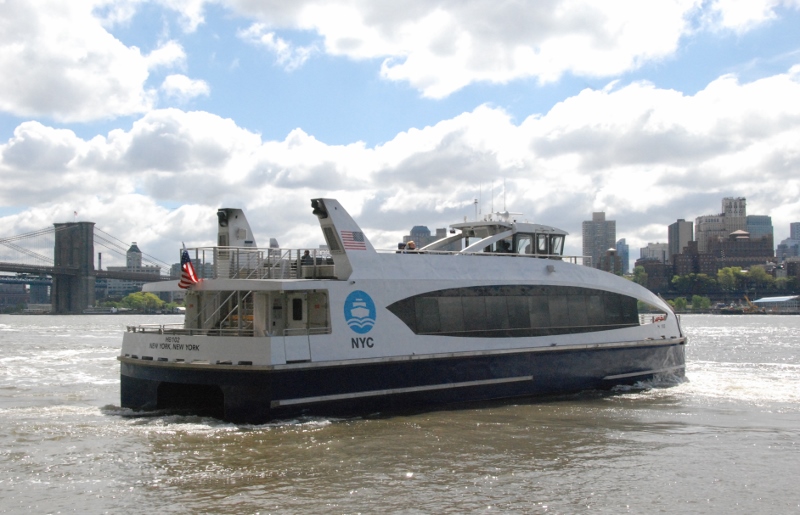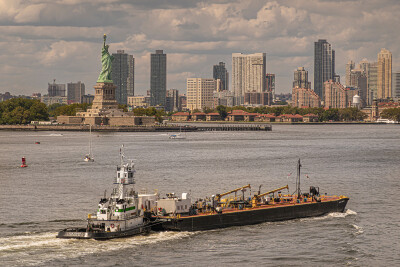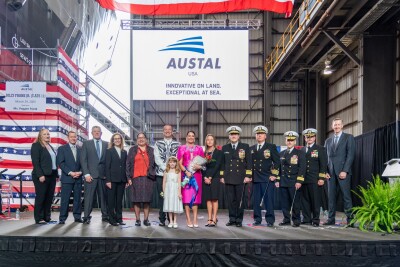In Rockaway, the farthest flung seaside corner of New York City, the A train will get you to Manhattan in an hour — if you are lucky.
So the first test of the new public NYC Ferry system has been its 45-minute run between Rockaway Beach in the New York City borough of Queens and Pier 11 at the foot of Wall Street. Early users are enthusiastic.
“I rented a house out there for a month to see if it’s doable. My wife loves it so far, walks on the beach every evening,” said Nolan Bauerle, riding on the topside deck as the ferry H101 passed northbound under the Verrazano Narrows bridge. “It’s one of the few neighborhoods in the city where property is affordable.”
Getting better transit options for underserved neighborhoods — and revitalizing them in the process — are official goals for New York Mayor Bill de Blasio’s administration, and its bold initiative to build a fleet of 20 ferries and stand up six interborough routes.

Hornblower CEO Terry MacRae, left, and Carl Wegener of Metal Shark look over the Brooklyn Army Terminal as the NYC Ferry H101 makes a stop. Kirk Moore photo.
“Right now Rockaway is running about 100 percent more than anticipated. This is transformative for them,” said Terry MacRae, CEO of Hornblower Cruises and Events, the parent company of operator NYC Ferry by Hornblower. “This is not just evolutionary, but revolutionary.”
Subsidized like other public transit, NYC Ferry costs $2.75 one way, same as a subway ride. Hornblower and its partners, the city Economic Development Corporation and shipbuilders Metal Shark and Horizon Shipbuilding Inc., hustled to meet a May 1 start date. The first 86’x29’ Incat Crowther-designed vessels arrived in early April, starting a fleet that will grow to 20 based at the old Brooklyn Navy Yard.
“We got the Coast Guard approval in early October,” said Carl Wegener, Metal Shark’s director of commercial sales. “Basically you take the engineering package to a whole other level.”
“We did a lot of things we borrowed from the automotive industry” in fabrication and production line processes, Wegener said. “Everything is 3-D modeled. Our workers are able to walk through the boat digitally before we ever start construction.”
So far, it’s working. The first two weeks of service to Rockaway and on the East River had only minor delays, including a slow-speed safety zone the Coast Guard established on the river while dealing with a May 7 spill from a power substation in Brooklyn.
“There was nothing extraordinary. We have engine software that was new to people and we’ve been optimizing that … just everybody getting used to stuff,” MacRae said.
The fleet will be comprised of 16 “river-class” boats, powered by pairs of Baudouin 6M26.3 engines each turning 815 hp at 2,100 rpm, and four deeper-draft variants for the Rockaway run, to handle bigger sea conditions in the lower harbor, MacRae said. The first of those Rockaway boats, with 20” additional freeboard and powered by the bigger V-12 12M26.3 engines with 1,400 hp at 2,100 rpm, should be arriving this week.
The Worldwide Ferry Safety Association held its conference in New York last week, and the final day included a midday round trip to Rockaway. There were a handful of commuters outbound, but passengers half-filled the 149-passenger vessel for the return to Manhattan.
Joe and Terry Curley, Rockaway residents of 45 years, said ferry service — first started as an expedient after Hurricane Sandy wrecked the transit infrastructure in late 2012 — has changed their lives.
“It was like a godsend after the storm, because the A train was out, and I worked downtown,” Terry Curley said.
Now retired, “we’re party people,” Joe Curley said. “We’re going in to have lunch in the city. We can have lunch, go to a matinee (show), and get back.”

Passngers board the NYC Ferry at Rockaway. Kirk Moore photo.
“New York is transit-rich,” said James Wong, a planner with the Economic Development Corporation. But a lot of neighborhoods close to the water’s edge do not have many travel options, and their bus and subway stops tend to be the last ones before Manhattan.
“So they’re packed, you might be waiting for two or three to go by” during rush hours, Wong said.
New ferry riders flocked to the service to the tune of 48,000 riders in the first week, 11,000 of them on the Rockaway route, according to city officials.
With public and private ferry service expanding across the city, Pier 11 will become an even busier terminal. MacRae said planning is underway for airport-style digital displays to direct passengers to their gates and update arrival and departure information.
NYC Ferry will have a new source of big data for its processes, with a ticketing app that allows patrons to purchase tickets on their smartphones. That will be kept confidential within the ferry system and will help tune up routing and schedule planning, MacRae said.
"Now we're getting real intel in real time," he said. "If you sign up for our app, we know where you go, where you get on, and where you get off."

The NYC Ferry H201 approaches the Pier 11 terminal on the East River. Kirk Moore photo.





